Nannup Holiday House by Iredale Pedersen Hook rises above the Australian bush on stilts
This zigzagging house in Australia by Iredale Pedersen Hook is raised above the ground on stilts to minimise its impact on the native landscape and wildlife (+ slideshow).
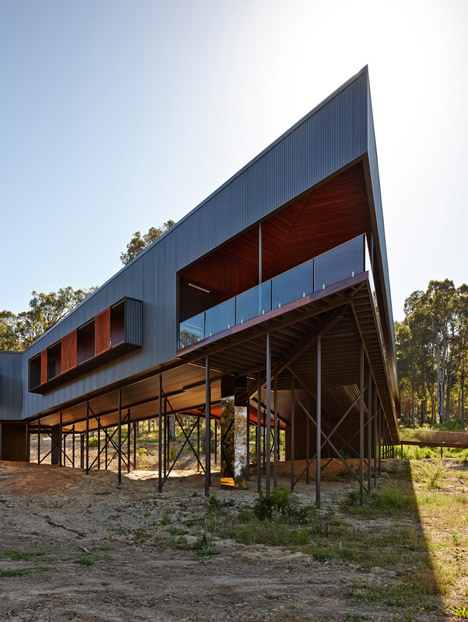
The holiday home was designed by Australian studio Iredale Pedersen Hook for a site near the town of Nannup. Situated between a forest and a flood plain, the area provides a habitat for local fauna including emus, kangaroos and snakes.
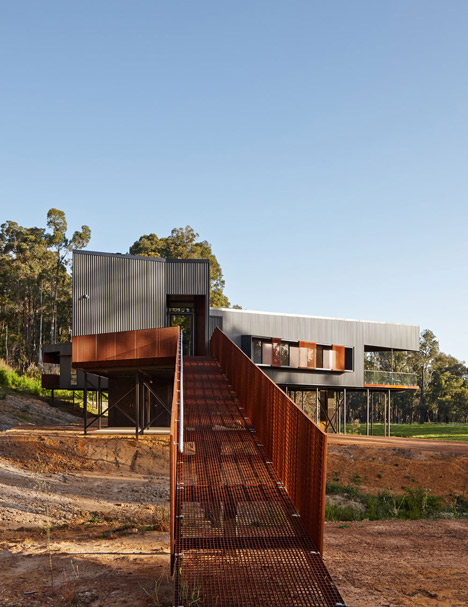
The house was given a cranked layout to create different experiences along its length. It was also lifted off the ground to enhance views and reduce disruption to the site.
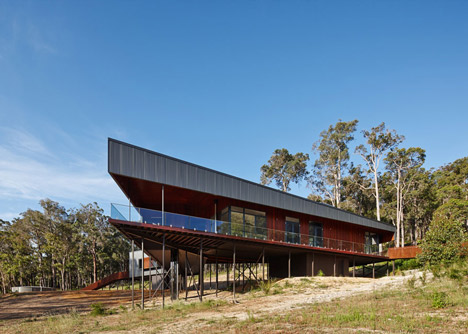
"This is a holiday house, a place of temporary inhabitation that offers a variety of experiences and relationship to the native landscape," said the architect. "Spaces are strung in a line, an open-ended line that allows one to enter, exist and then leave and continue."
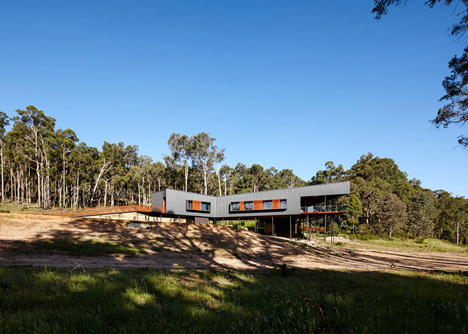
The kinked plan optimises different views of the forest on one side and the horizon on the other. It accommodates outdoor living areas, including an enclosed balcony at the rear of the property and a pointed terrace that projects towards the flood plain.
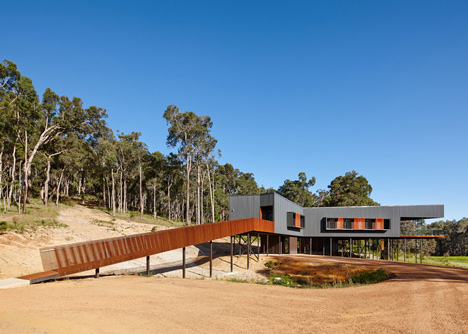
Windows on the angled facades alternate between vertical apertures that make the most of the view towards the nearby trees and longer openings overlooking the plain.
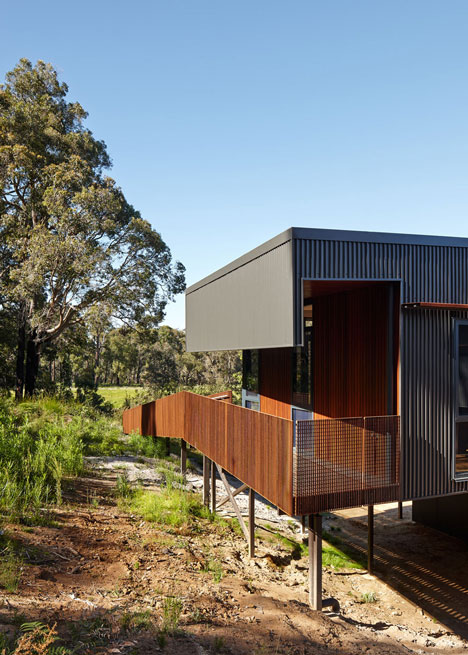
The use of the stilts and their diagonal cross-braces references the fallen trees that are a common feature around the forest edge, while the material palette used for the exterior references its natural setting.
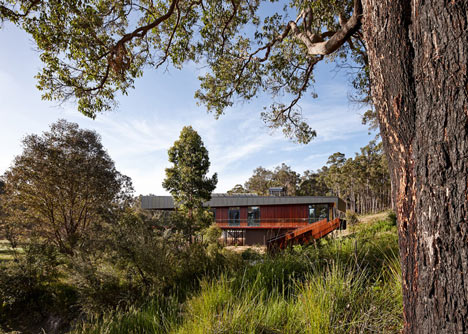
"Materials were carefully selected to dialogue with the context," the architects explained. "Dark Colorbond steel, rusting steel and recycled jarrah [wood] contributes to the notion of the building as 'shadow'."
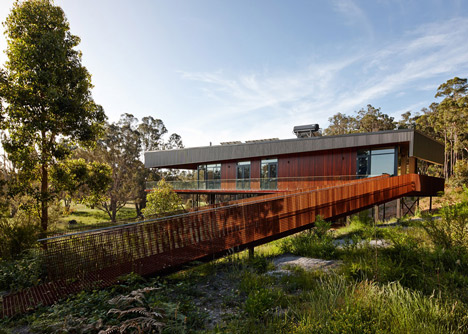
Long steel grate ramps lead to an entrance at one end of the house and a balcony at the other, continuing past the master bedroom and main living areas to the sheltered terrace.
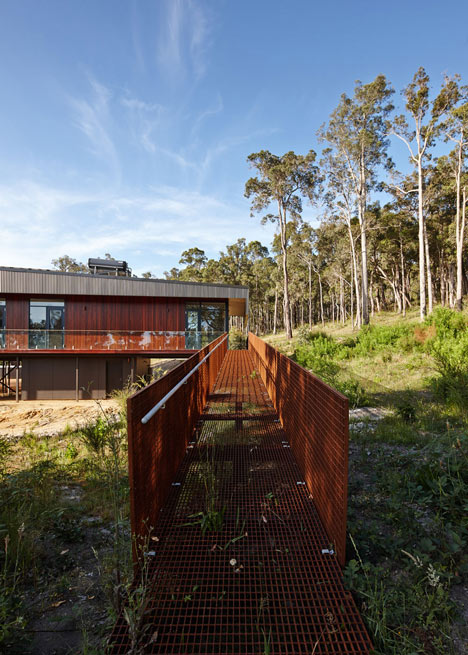
The main entrance opens into a dark corridor that meanders past bedrooms, a laundry and a study, before reaching the two terraces on either side of the bright, open-plan living and dining room.
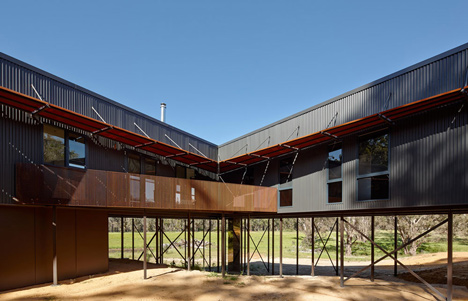
The architects said they wanted to enhance the experience of moving between interior and exterior spaces by emulating the experience of "wandering through a forest in and out of darkness and openness."
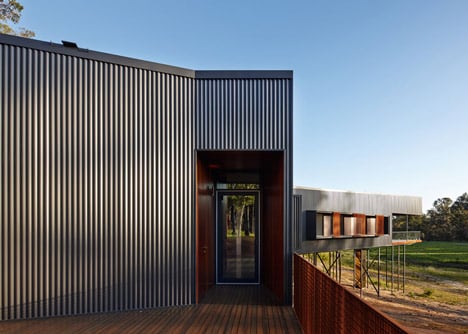
Richly textured, dark jarrah wood used on the floor of the corridor contrasts with the bright living spaces, while carefully chosen colours and textures were introduced throughout the interior to evoke the natural surroundings.
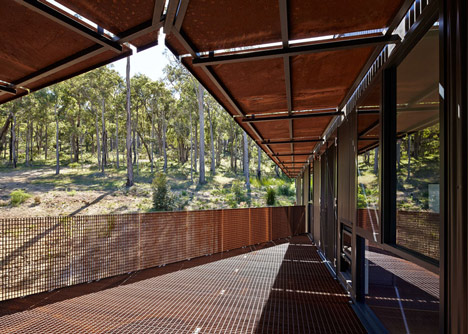
Treated plantation pine was used for 90 per cent of the building's framework and recycled local timber features on the outdoor decks as well as internal flooring and storage.
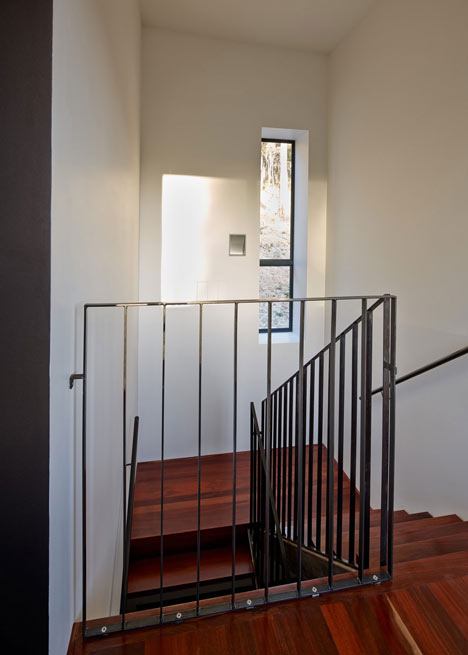
Photovoltaic panels on the roof supply the home's power and a solar-powered system heats its water, which includes rainwater captured from the roof.

Photography is by Peter Bennetts.
Here's a project description from Iredale Pedersen Hook:
Nannup Holiday House
The Nannup Holiday house forms part of a wandering path through the landscape from Perth to Nannup. This path dialogues with the landscape of intense forest, meandering river and rolling hills, each experience is carefully choreographed to enrich the occupancy of the house. A Jeykll and Hyde experience of the landscape is carefully controlled through oscillating vertical (forest) and horizontal (horizon) openings and the contrast of grounded and floating experiences. While the exterior dialogues with the numerous fallen trees, the interior is revealed through a sequence of 'growth rings' coded and extruded in relation to the building program.
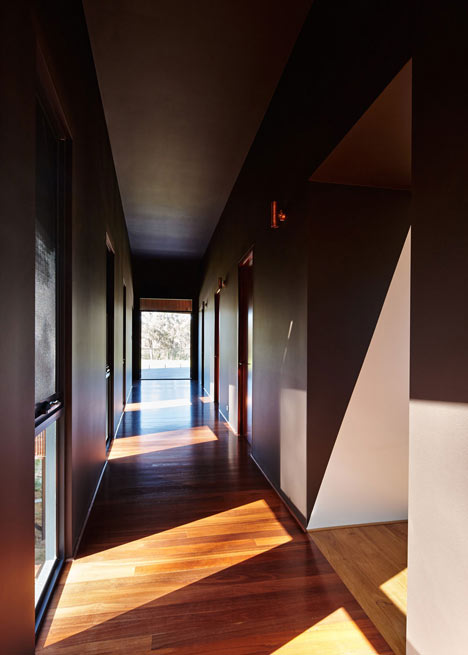
Program Resolution
This is a holiday house, a place of temporary inhabitation that offers a variety of experiences and relationship to the native landscape. Spaces are strung in a line, an open-ended line that allows one to enter, exist and then leave and continue. The house is part of a broader and longer experience that constitutes the experience of being on 'holiday', the travel to and from the site and the experience of visiting local towns and tourist attractions are then contemplated and celebrated in the context of this residence. Spaces are organised to provide a sense of seclusion and retreat, guests view the forest from a distance through vertical windows, the boys view the horizon and rolling hills through shared horizontal openings and the parents almost touch the natural landscape. These areas are collected by a dark, twisting and cranking space clad in recycled jarrah that oscillates between interior and exterior creating a sense of ambiguity and wondering through a forest in and out of darkness and openness. Outlook from this space is carefully controlled to provide detailed relief, openings also align to view through interior to exterior to interior and back to exterior.
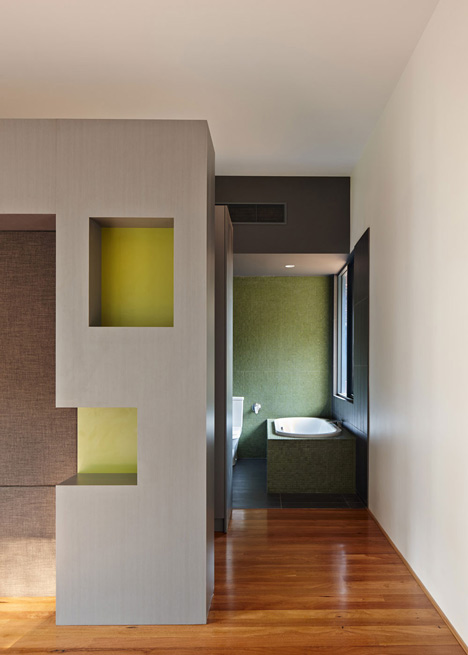
Built form context relationship
The building hovers above the native landscape minimising disturbance, it is a shadow to the immense forest, cranking in plan and undulating in section. The plan twists in relationship to program requirements and variety of views. The section undulates in direct dialogue to the backdrop forest enriching the spatial experience with variety and complexity; spatial proportion varies between rooms capturing the verticality of the forest and the horizontality of the horizon.
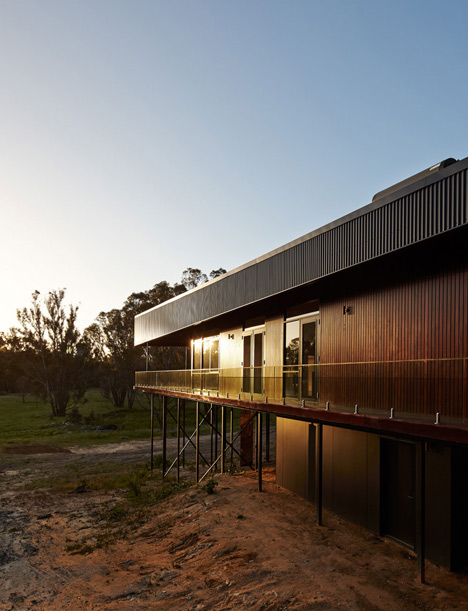
It sits between the edge of the forest and the edge of the flood plain, the space between fire and flood, a fragile zone of existence. The ground level is dominated by roaming wild pigs (the size of humans), tiger snakes, dugites and other less threatening native fauna including emus and kangaroos. The elevated house with access via the steel grate ramps creates a safe retreat to observe nature.
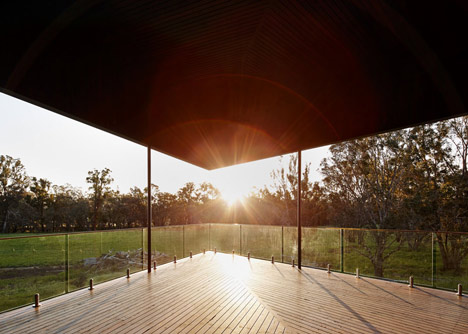
Materials were carefully selected to dialogue with the context, dark Colorbond steel, rusting steel and recycled Jarrah contributes to the notion of the building as 'shadow'. This concept continues internally, the main passage being dark and an extension of the exterior (recycled Jarrah) and primary living spaces being lighter and more connected to the exterior (recycled WA Blackbutt). Small fragments of intense colour capture the colours of the forest undergrowth.
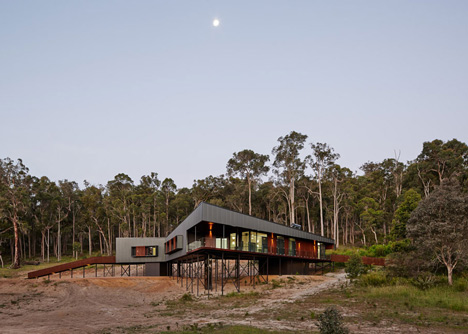
Integration of Allied Disciplines
The core building team camped on site during construction; it became an obsession, highly crafted and full of pride. Our structural engineer also travelled regularly to site while visiting his own holiday farm in the vicinity. His knowledge of local conditions and contractors was highly valued. The project enjoyed a high level of respect and collaboration between all teams; this is reflected in the end result.
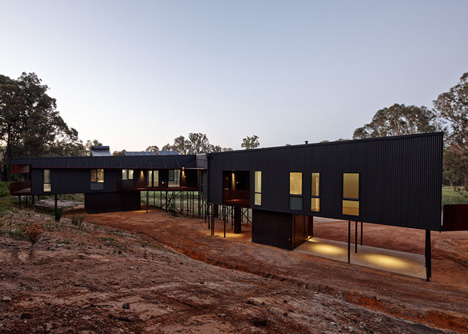
Sustainability
This project offers a holistic approach to environmental sustainability commencing with design and placement of access paths. The vehicle access path is placed along the site edge an area that requires annual clearing for the firebreak. This enables us to minimise the clearing of land. The materials required to build the access path were quarried from the site (gravel and clean yellow sand). These areas were immediately rehabilitated with plant species already existing on the site.
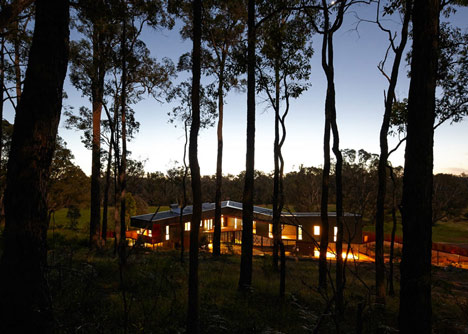
The house was sited and designed to minimise clearing of bush and removal of trees. The area under the house is then free for re-introducing local species and will be fed by the grey water recycling.
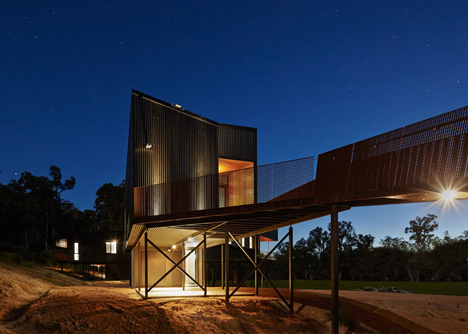
Materials were selected based on a life cycle analysis of embodied energy, Colorbond cladding provides a durable exterior core and inhabited areas include recycled Jarrah and recycled WA Blackbutt. Timber off cuts was re-used for storeroom linings.
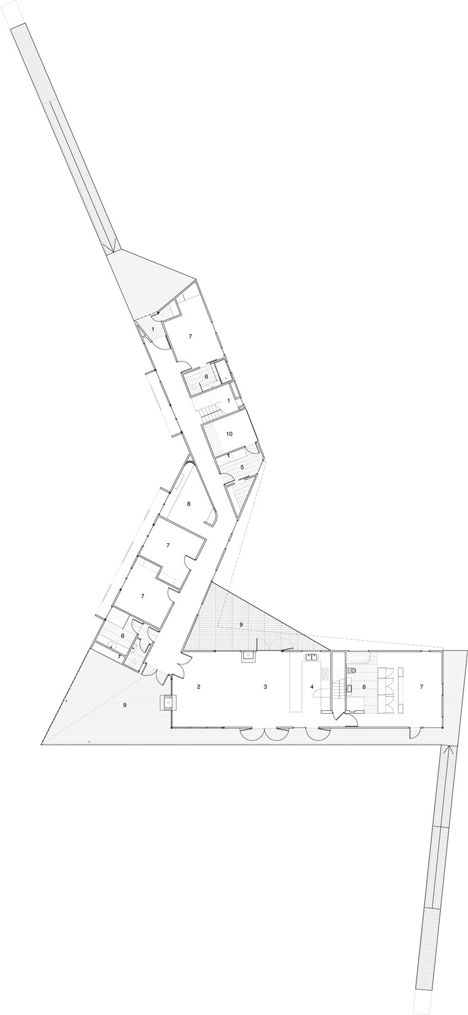
The building structure is 90% treated plantation pine and most furniture constructed from hoop pine plantation plywood. The structure was mostly pre-fabricated to minimise building waste.
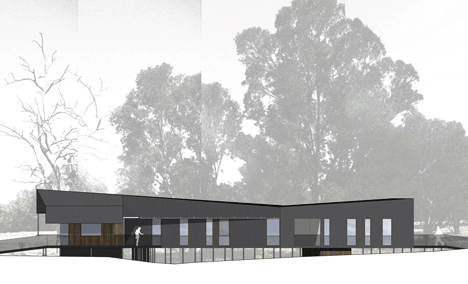
The long roof form increases the capacity to capture rainwater, this is re-used in the house. Grey Water is recycled for garden watering under the house. Water is heated from a solar hot water system with back up instantaneous gas hot water systems located close to areas of water use to minimise water waste. Water consumption is reduces with rated fixtures and fittings.
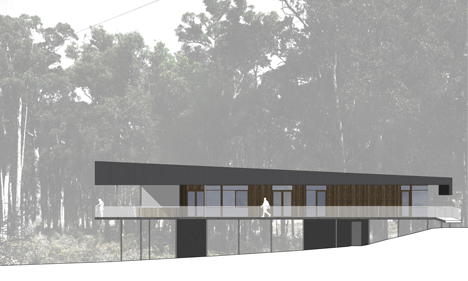
Photo Voltaic cells balanced over the year easily cover consumption requirements. Power consumption is minimised through energy efficient equipment, use of LED and Compact Fluorescent globes and feature wall mounted light fittings manufactured from plantation plywood.
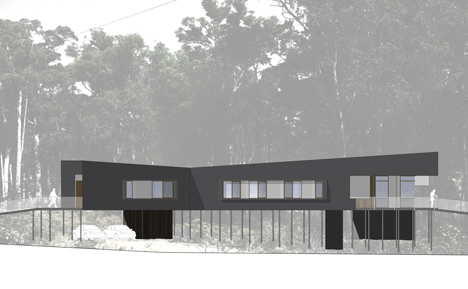
Applied coatings are minimised and generally Low Voc or oil.
Architects: Iredale Pedersen Hook architects
Architectural Project Team: Adrian Iredale, Finn Pedersen, Martyn Hook, Drew Penhale, Caroline Di Costa, Jason Lenard, Matthew Fletcher, Tyrone Cobcroft
Structural Engineer: Terpkos Engineering
Builder: Brolga Developments and Construction